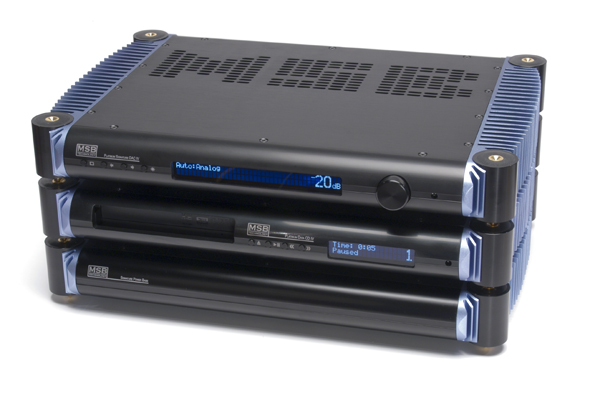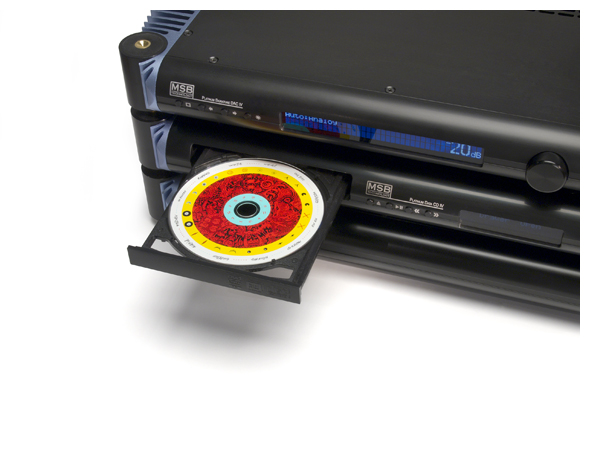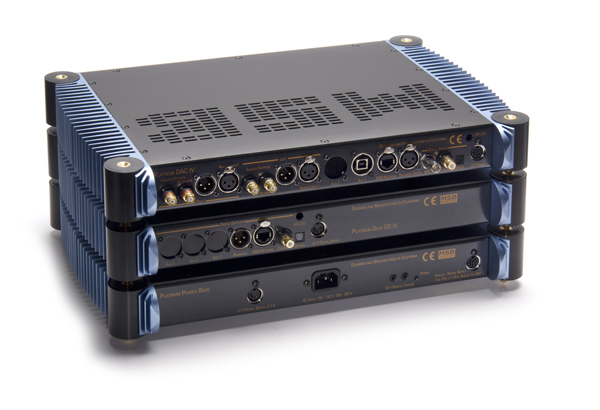 Digital audio doesn’t have a sound, per se. What we describe as digital sound is the sound of analog-to-digital and digital-to-analog conversions. There’s not much we can do about the A-to-Ds used when music you love is recorded, mixed, or mastered, but as for the D-to-A conversions, the MSB Technology Platinum Data CD IV Transport and Platinum Signature DAC IV sound as good as digital gets.
Digital audio doesn’t have a sound, per se. What we describe as digital sound is the sound of analog-to-digital and digital-to-analog conversions. There’s not much we can do about the A-to-Ds used when music you love is recorded, mixed, or mastered, but as for the D-to-A conversions, the MSB Technology Platinum Data CD IV Transport and Platinum Signature DAC IV sound as good as digital gets.
Many analog lovers are certain that vinyl is more musical while digital devotees claim the zeroes and ones approach is by-the-numbers accurate. Vinyl’s sins are mostly additive: analog has higher levels of distortion, speed variability, and noise issues, but digital somehow loses the juicy richness we associate with the sound of the proverbial real thing. Each camp stakes its claim of sonic superiority and often dismisses the opposite side’s formats as non-musical garbage, and I swear the name-calling has been going on since analog was first converted to digital. That’s not to say there aren’t audiophiles that straddle the analog/digital gap. I include myself in that group.
MSB’s Technology Platinum Data CD IV Transport and Platinum Signature DAC IV narrow the analog-digital divide, and again remind me of the source’s role in determining the sound of my hi-fi. It really comes down to this: If musical information is “lost” at the source, it can’t ever be regained with better amps or speakers. The old garbage-in, garbage-out credo still stands, and improvements made at the beginning of the chain—the source—are huge.
Being Discrete
The $3,995 Platinum Data CD IV Transport and $17,489 Platinum Signature DAC IV are available in Matte White (a.k.a. silver) or Satin Black; heat sinks on the chassis sides come in silver, black, or blue. The DAC offers an extensive (and at times, bewildering) range of set-up options. Input switching modes, digital filters, and dither options via the remote. The US-made DAC IV is discrete. It doesn’t utilize Burr-Brown or any off-the-shelf chips to convert digital-to-analog, and that’s a really big deal. MSB rolls its own ultra-high resolution, up to 384-kHz/32-bit DAC modules in-house, achieved straight through with no complicated side operations. The DACs use high-precision aerospace grade resistors, specifically selected and matched for use in the Signature DAC. The modules can be upgraded down the road, so a Platinum can become a Signature and a Signaure can become a Diamond. The front end of the DAC IV series uses the largest blank SHARC chipsets available containing four digital filters, input receivers and two upsampler algorithms all written in-house. It was designed to be field upgradable with firmware downloads for new digital filters, future formats and many other pre-conversion functions. Analog and digital sections are completely isolated from each other.
You can configure your Platinum Signature DAC IV with a range of options, including the Signature volume attenuator for $2,295; the Signature USB 2 384 kHz board for $1,395; a remote control power on/off feature for $485; a second analog input for $995; and an integrated iLink (iPod dock) for $1,995.
After inserting a disc, the Transport starts reading and rereading the disc and puts the data in a memory, like a computer-disc transport would. MSB engineers listened to and tested dozens of drives before selecting the one employed in the Data CD IV. This drive performs just one function—it reads the data from the disc and the Data CD IV’s custom-designed electronics control the drive. This approach is what separates its performance from other transports. Jitter is reduced to the point that MSB had to develop its own measurement system to more accurately monitor the readings.
The Transport requires an outboard 12-volt power supply, and MSB offers two options: a small desktop supply ($595) or a MSB Platinum Power Base that comes with a MSB Platinum DAC. The Data CD IV’s performance is the same with either power supply. The Transport has AES-EBU, RCA coaxial, Toslink optical, and MSB’s proprietary Network digital outputs.
The DAC claims the same connectivity options as inputs, plus a 75-ohm BNC digital input an XLR or RCA analog input that passes through the purist volume attenuator, as well as RCA and XLR analog outputs. Perhaps the highest resolution is available via MSB’s new Pro I2S MSB-Network connection, featuring ground isolation, higher bandwidth and markedly lower jitter.
Visually, the Data CD IV Transport and DAC IV are much prettier than any previous MSB Tech components I’ve seen. The deeply rounded front fascia and low-slung chassis are flanked by gently curved heat sinks. The underside of the chassis’ four corners are stocked with brass pointed feet, and the corresponding top corners are fitted with inserts to accept a stacked MSB component’s pointed feet.
Physically, the Data CD IV feels nice and solid, but the generic plastic disc-loading tray and tiny transport control buttons seem out of place on gear that pushes the state of the art. Granted, they don’t make a whit of difference to the sound, but I’d love to see a machined metal tray for this kind of money. The tray is the primary point of contact with the Transport, and it breaks the high-end spell. The Transport and DAC are also each shipped with a lightweight aluminum-faced remote control. Again, they’re nothing fancy, but the remote works well, and I prefer it to the massive devices that come with some high-end components.
I’ll quickly concede that higher-than-CD-resolution digital gets closer to analog’s musical nature, but there’s precious little new music coming out on Blu-ray, SACD, DVD-A, or high-resolution download these days. By far, the CD is still the best-sounding widely distributed digital format. I own around 3,000 CDs and buy on average two per week, and I want to hear them at their best. Presto: The MSB components made the little silver discs sound better than ever. So much so I didn’t shed a tear when I discovered the Platinum Data CD IV Transport doesn’t play SACD or DVD-A discs, but spins DVD-ROMs encoded with WAV files with up to 384 kHz sampling rates with 32-bit resolution. If you possess a large SACD/DVD-A collection, check out MSB’s $3,995 Universal Media Transport. (review in process)
Before starting a review of digital gear, I like to exclusively listen to LPs for a few days. The process clears my head. The MSBs acquitted themselves well during the first few plays—not so much that they sounded analog-like, but sounded good. Really good. As I played a stack of CDs, the MSBs connected the dots better than most digital gear I’ve heard.
I spent some time running the Platinum Signature DAC IV straight into my Pass Labs XA100.5 amps, and controlling the volume from the DAC. Sure, this approach is possible with some other DACs, but I’ve never actually preferred this method to using a preamp between DAC and amp. It makes a lot of sense to eliminate the preamp, but too often, dynamics go south and the sound loses too much of its essential mojo. Not this time. Straight-in, the DAC was a smidge more transparent, soundstaging more open, and focus better. Dynamics were better straight-in than with my Parasound JC-2 preamp in the chain. If you don’t have a lot of other analog sources (the DAC can be configured with up to two RCA and XLR analog inputs), you might want to forgo a preamp altogether. For those already possessing a high quality linestage, the purist attenuator can be switched out completely.
While listening to 176.4 kHz/24-bit hi-res music from Reference Recordings’ HRx Sampler 2011 DVD-ROM disc, the sound was nothing less than astounding. To my ears, high resolution gets you closer to being in the venue as you hear more low-level atmospherics. The illusion of being in a concert hall ranks ahead of what I’ve heard from SACD or DVD-A surround discs. The soundstage on the Reference disc may be strictly two-channel, but it’s so huge, I felt no loss of surround. Uninhibited large-scale dynamics, like the big bass drum that opens Walton’s Crown Imperial finale, just about knocked me over and had me reassessing my Magnepan 3.7 speakers’ dynamic capabilities.
The small- and large-scale dynamics on the disc’s solo piano tracks were, again, the most lifelike I’ve heard at home. The studio-recorded jazz tracks’ more intimate soundstage perspective added a degree of presence that made returning to CD an unpleasant option. So I popped in a 96-kHz/24 DVD-ROM of Paul Simon’s recent So Beautiful or So What album. It’s not an audiophile recording and, compared to the Reference Recordings’ discs, it’s dynamically compressed and processed-sounding. But it’s not bad. It’s also Simon’s best effort in years, and the lovely acoustic guitar picking on the instrumental “Amulet” is awfully pretty.
The MSBs let me hear more low-level (quiet) sounds in my CDs. Reverb, whether natural or added in the mix, seemed newly apparent in recordings I’d heard hundreds of times. It’s always been there, but no digital playback system I’ve had at home boasted the resolution to reveal it. Having worked on a number of Chesky Records sessions, including dozens recorded at St. Peter’s Episcopal Church in NYC, I can state for certain that the MSB Transport and DAC resurrected more of the 173-year-old building’s sound than I’ve ever heard from the CDs, SACDs, or DVD-As). The CDs never came close to this level of resolution. And, as you hear more deeply into a recording, soundstage focus and dimensionality are also enhanced.
 Reconsidering the Analog-Digital Divide
Reconsidering the Analog-Digital Divide
In the great analog-digital divide, for me, engagement remains analog’s key advantage. I feel more connected and involved with music when listening to analog. And yet, the MSBs are distinctly more analog-like on these emotional fronts. Rhythm and pace are better than what I’ve come to expect. Imaging is another key strength: Instruments and voices project sound—if not in a complete 360-degree, omni-directional pattern, then something close to that experience. Of course, it’s rare to reproduce a combination of direct and reflected sound over a hi-fi system. The fact is that information isn’t found on most close mic’d recordings; the “space” is an effect added in the mix.
You’re much more likely to hear these details with so-called audiophile recordings since they take place in acoustically interesting places as opposed to acoustically dead studios. Howard Levy & Miroslav’s The Old Country CD on MA recordings equated to a full-blown, virtual-reality experience. Engineer Todd Garfinkel records with a pair of B&K mics placed above the musicians. Via the MSBs, his mic technique was crystal clear, the spatial relationships between musicians perfectly rendered. No other digital playback gear came close to revealing this kind of accuracy, including my long-standing reference, the Ayre C-5xe mp SACD/DVD-A player. The latter remains a great machine, but blurs the instruments’ outlines and flattens the soundstage. The MSB duo is a much sharper “lens.”
So it came as something of a shock when the MSB worked its magic on less-than-stellar recordings like Trio Beyond’s live Saudades CD. I’ve always enjoyed Jack DeJohnette, Larry Goldings, and John Scofield’s music, but it’s zippy, fuzzy, and nasty-sounding. Yet the MSB somehow toned down the negatives. My Japanese pressing of Jethro Tull’s Bursting Out is another live recording that was previously too aggressively bright and thin to really enjoy, and yet the MSBs fleshed out the sound. That’s good news, because hearing 1978-era Tull blast through “Cross-Eyed Mary,” “Aqualung,” and “Thick as a Brick” is freaking awesome.
Admittedly, the MSB Technology Platinum Data CD IV Transport and Platinum Signature DAC IV are expensive, but the best stuff almost always costs. Then again, the components are also about as future-proof as digital gets, so it’s the sort of digital gear in which you can invest for the long haul. The analog-digital divide has never been smaller.
MSB Technology Data CD IV Transport
MSRP: $3,995
MSB Signature DAC IV with Signature Power Base
MSRP: $17,489
http://www.msbtech.com
Peripherals
| Analog Source | VPI Classic turntable with a van den Hul Frog cartridge |
| Digital Sources | PS Audio PerfectWave DAC Oppo BDP-83 Special Edition |
| Electronics | Parasound JC 2 preamp Pass Labs XP-20 Whest 2.0 phono preamp Bel Canto REF500S Pass Labs XA100.5 First Watt J2 power amps |
| Speakers | Dynaudio C-1 Zu Essence Mangepan 3.6 Magnepan 3.7 |
| Cable | XLO Signature 3 interconnects Analysis Plus Silver Oval interconnects and speaker cables Audioquest Sky interconnects |















